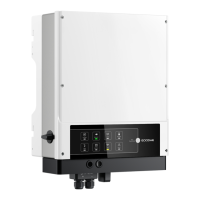Questions & Answers (Q & A)
Wi-Fi Configuration
Q: Why can't I find the Solar-WiFi* signal on mobile devices?
A: Normally the Solar-WiFi* signal can be detected immediately after powering up the inverter.
However, the Solar-WiFi signal will disappear when the EM unit connects to the internet. If you
need to change settings, connect via the router instead. If you can't find the Wi-Fi signal or
connect to the router, please try to reload the Wi-Fi settings (refer to 3.1 Wi-Fi Configuration).
Q: Why can't I connect to the Solar-WiFi* signal on my phone?
A: The Wi-Fi module can only connect to one device at a time. If the signal is already connected to
another device, you will be unable to connect to it using your phone.
Q: Why does the Wi-Fi module fail to connect to the network after I select the correct
router hotspot and enter the right passwords?
A: It's possible that your hotspot password contains special characters not supported by the
module. Please modify your password to include only Arabic numerals and or uppercase/low-
ercase letters.
Battery Operation
Q: Why does the battery not discharge when the grid is not available, while it discharges
normally when grid is available?
A: On the app, the off-grid output and back-up functions must be enabled for the battery to
discharge in off-grid mode.
Q: Why is there no output on the back-up side?
A: To enable the back-up supply, "Back-Up Supply" on the PV Master app must be turned on. In
off-grid mode or when grid power is disconnected, the "Off-Grid Output Switch" function must
also be turned on.
Note: When enabling the "Off-Grid Output Switch" function, don't restart the inverter or battery,
otherwise the function will be switched off automatically.
Battery does not charge:
Solution:
1. Ensure BMS communication is OK using the PV Master app (for lithium batteries).
2. Check that the CT is connected in the correct position and direction, as per chapter 2.4.4:
Smart Meter & CT Connection.
3. Check whether the total load power is much greater than PV power.
Q: With lithium batteries, why does the battery switch always trip when it is started up?
A: The lithium battery switch will normally trip for the following reasons:
1. BMS communication fails.
2. Battery SOC is too low, and the battery trips to protect itself.
3. An electrical short-circuit occurred on the battery connection side. There may be other
reasons. Please contact after-sales support for further information.
Q: Which battery should I use with the EM series inverter?
A: Lithium batteries compatibility with EM series inverters, and with a nominal voltage of 48V can
be used. For compatible lithium batteries please refer to the battery list in the PV Master app.
PV Master Operation and Monitoring
Q: Why can't I save settings in the PV Master app?
A: This could be caused by loss of connection to the Solar-WiFi * signal.
1. Ensure you have already connected to Solar-WiFi* directly (if no other devices are connected)
or via the router (if you have connected Solar-WiFi* to your router). The app's homepage
should display if the connection is working.
2. Make sure you restart the inverter 10 minutes after changing settings, since the inverter will
save settings every 10 minutes during normal operation. We recommend changing settings
when inverter is in standby mode.
Q: Why is the information displayed on the homepage different from that on the param
page, for e.g., parameters such as charge/discharge, PV value, load value or grid value?
A: The data refresh frequency varies, so there may be inconsistencies between information
displayed on different pages in the app, as well as between the portal and the app.
Q: Some columns (e.g. battery SOH) display NA. Why does this happen?
A: NA indicates that the app has not received data from the inverter or server due to a
communication problem e.g., with battery communication or communication between the
inverter and the app.
28
27

